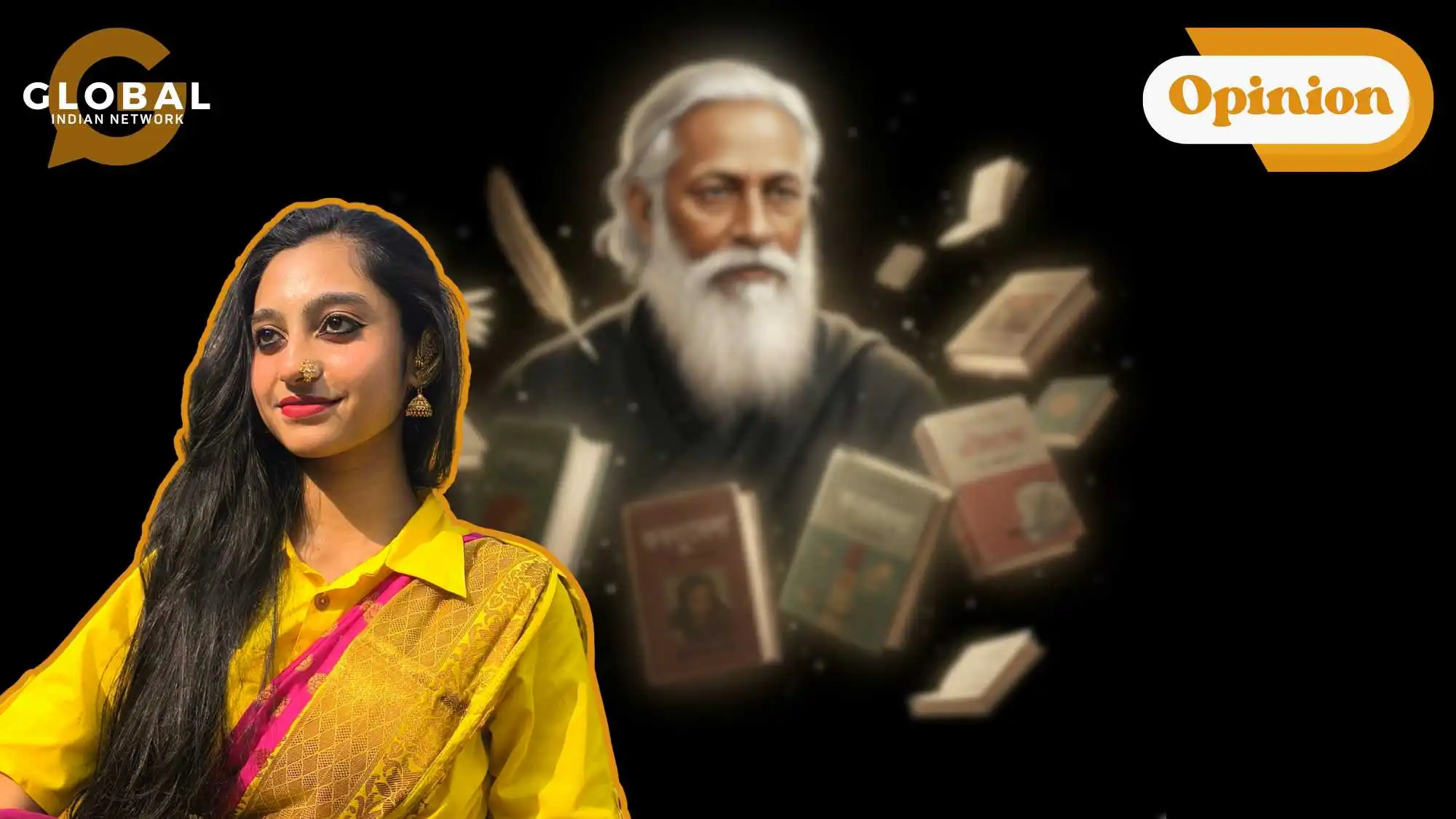The discourse in our English class took an unexpected turn this morning. Our teacher, with an air of global concern, reflected on how our generation, in striving to be cosmopolitan, was slowly erasing the imprints of its own linguistic soil. She posed a question: Could anyone, with conviction, name even five writers from their native tongue? It was less of an inquiry, more of an assertion. When someone uttered “Premchand,” breaking her dominating silence in the classroom, she stuttered, as though that answer was unexpected, and offered a smile, remarking that Hindi, being a widely inhabited language, naturally lent itself to recognition.
Then came her next words, which pulled a nerve in me. “But what about the others? Malayali, Assamese, Bengali, all these?” The phrasing struck like a subtle illiteracy wrapped in academic civility. I felt a slow indignation rise within me.
To hear Bengali literature, a tradition that has sculpted a whole different path of thought, began rebellion by just words, and tenderness in ways unmatched, reduced to a mere afterthought, in a classroom of literature, taught by an allegedly educated ‘professor’ was an irony too bitter to ignore. I sat there in disbelief, wondering how I could be HERE. I’m writing this so that the next time any person dares to pick up such a topic, you do not sit silent.
Let’s begin with literature itself. And before we allow the rhetoric of globalism to overshadow the roots that shaped our collective mind, let’s recall the one and only Rabindranath Tagore, the holy foundation of the nation’s literature. The first Asian to receive the Nobel Prize in Literature in 1913 for Gitanjali. Remember, folks, we are not simply talking about a Bengali writer; he was the conscience of an India struggling to define itself. His verses transcended language, speaking to the human spirit in tones that were both intimate and infinite.

But Tagore’s contribution was not confined to art alone. It spilled into the bloodstream of the nation’s freedom. While others raised slogans, Tagore cultivated thought. His poetry became a rebellion that was soft, a spiritual resistance to colonial subjugation. He envisioned freedom not merely as political liberation but as the emancipation of the human soul. In Ghare-Baire (The Home and the World), he questioned blind nationalism, warning against the dangers of fanatic pride even as he nurtured the essence of patriotism. He returned his damn knighthood in 1919 in protest of the Jallianwala Bagh massacre.
The anthem, you feel so patriotic with, who on earth wrote that? Besides giving our country its hymn, he gave another nation their paean of belonging, “Amar Shonar Bangla”. He founded Visva-Bharati at Santiniketan, a university built on the idea that education should dissolve boundaries between countries, disciplines, and minds. His letters with Gandhi revealed the rarest kind of dialogue- one where poetry met politics, and truth met humility. “Where the mind is without fear and the head is held high.” Tagore’s vision of Swaraj was not a slogan; it was an awakening, a call for the mind to be fearless.
To speak of Bengali literature as something lesser is not ignorance; it is amnesia, for Tagore did not belong to Bengal alone. Bengal was the vessel through which he spoke to the world. Without him, India’s freedom movement would have lacked its most lyrical conscience, and world literature its most serene rebel.
Michael Madhusudan Dutt, the fiery comet who first turned his gaze westward, was enamoured by Milton and Shakespeare. He sought to clothe his intellect in the robe of the English tongue, believing perhaps that greatness lived only across the seas. But the deeper he ventured into the Western ideal, the more he felt the absence of his own soil beneath his feet. When he returned to Bengal, he was no passive student; he devoured them, dissected them, and then rose to overpower them.
In English, he dared to match Shakespeare’s command of drama, the grandeur of Milton’s verse, the very thunder of their diction, and he did so with a fire that no foreign tongue had yet seen from an Indian pen. He brought with him the thunder of English epics and poured it into the river of Bengali verse, giving birth to Meghnad Badh Kavya, a masterpiece that redefined the idiom of heroism. Ask your arrogance to match his brilliance.
Enough of the gentle literature. Let’s introduce our Bidrohi kobi, Nazrul Islam. He wielded Bengali, Arabic and Persian influences, blending them into something that demanded attention, a cadence that held the captivated folks by their belts. He challenged the British, questioned social hierarchies, and celebrated the dignity of labour, love, and liberty, all in a language that burned with passion.
Where Tagore philosophised, Nazrul erupted. He proved that Bengali literature is not just the foundation of the nation but the flame that can ignite freedom and courage in every corner of the world. To ignore him is to deny the very voice of resistance, the roar of a people unwilling to bow, the living heartbeat of Bengal’s undying literary insurgency.
“প্রার্থনা করো- যারা কেড়ে খায় তেত্রিশ কোটি মুখের গ্রাস, যেন লেখা হয় আমার রক্ত-লেখায় তাদের সর্বনাশ।” We do have a junior Islam, Sukanta Bhattacharya, the Kishore Bidrohi Kobi. He wrote during a period of immense turmoil: the Bengal famine of 1943, World War II, and the rising anti-colonial movement. He gave poetic voice to the oppressed, the poor, and the working class. His poems did not shy away from depicting the harsh realities of life but combined them with hope and a call for social change. In this sense, his contribution goes beyond literature- it is also political and humanistic. But he got to envision Bengal for only twenty years.
The Bengal canon is saturated with such examples; describing them would elongate this article to a thesis. But know these names for your upcoming arguments. Ishwar Chandra Vidyasagar, Bankim Chandra Chattopadhyay, Dinabandhu Mitra, Rajendralal Mitra, Dwijendralal Roy, Rajanikanta Sen, Swami Vivekananda, Upendrakishore Ray Chowdhury, Abanindranath Tagore, Sukumar Ray, Sarat Chandra Chattopadhyay, Kazi Nazrul Islam, Premendra Mitra, Jibanananda Das, Bibhutibhushan Bandopadhyay, Tarashankar Bandopadhyay, Manik Bandopadhyay, Bonophool (Balai Chand Mukhopadhyay), Buddhadeb Basu, Achintya Kumar Sengupta, Annada Shankar Ray, Subhash Mukhopadhyay, Parashuram (Rajshekhar Basu), Narayan Gangopadhyay, Leela Majumdar, Amiya Bhushan Majumdar, Samaresh Basu, Sunil Gangopadhyay, Shakti Chattopadhyay, Alokeranjan Dasgupta, Buddhadeb Guha, Joy Goswami, Mahasweta Devi, Shirshendu Mukhopadhyay, Samaresh Majumdar, Nabaneeta Dev Sen, Kabita Singha, Binoy Majumdar, Mallika Sengupta, Nabarun Bhattacharya, Ranjan Bandyopadhyay, Pabitra Sarkar, Syed Mujtaba Ali, Hasan Azizul Haque, Shamsur Rahman, Al Mahmud, Syed Shamsul Haq, Humayun Ahmed, Selim Al Deen, Taslima Nasrin, Imdadul Haq Milan, Selina Hossain, and the list never really ends.
Let us turn our attention to India’s ever-expanding cinematic realm. What is Bollywood without Arijit Singh and Shreya Ghoshal? What is cinema without Satyajit Ray? It would be a world stripped of its introspection, a medium bereft of the poetic intonation that transforms the mundane into the sublime. His lens became a philosophical instrument, interrogating social hierarchies.
In the absence of Ray, cinema loses its capacity to move without spectacle, to interrogate without moralising, to render the ordinary with transcendent empathy. He reminds us that film can be both a mirror and a meditation. Satyajit Ray’s body of work is a meticulous exploration of human existence and the subtle tensions that define everyday life. Across his films from Pather Panchali and Aparajito to Charulata, Mahanagar, and Shatranj Ke Khilari, and the most loved, Gupi Baghar Kando, & Hirak Rajar Deshe, Ray portrayed mass issues through individual characters.
A recurring aim in his cinema was to lay bare the dogmas, rigid hierarchies, and inherited traditions that govern human behaviour. In Charulata, he examined the stifling patriarchy and emotional repression imposed on women in upper-middle-class Bengali society. Mahanagar highlighted the tension between modernity and tradition, portraying a working woman negotiating societal expectations while asserting her independence. Even in films like Shatranj Ke Khilari, set in historical India, Ray subtly critiqued the complacency and ritualistic adherence to outdated norms that blinded society to looming crises.
Well, this isn’t even half of what Bengali culture holds, and yet some philistine people under the shield of academic veneer dare to belittle it. Dare you name five authors from your native language, Professor?

Let us know your thoughts. If you have burning thoughts or opinions to express, please feel free to reach out to us at larra@globalindiannetwork.com.









